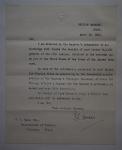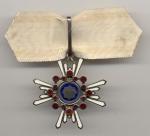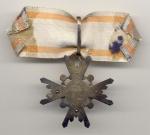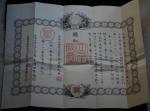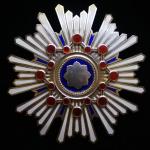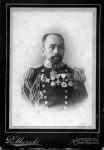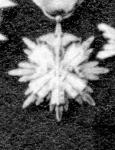-
Posts
2,123 -
Joined
-
Last visited
-
Days Won
4
Content Type
Profiles
Forums
Blogs
Gallery
Events
Store
Everything posted by Paul L Murphy
-

Making sense of it all - Sacred Treasures of known award date....
Paul L Murphy replied to Paul L Murphy's topic in Japan
Paul, Both Bredon and Maze had a number of Chinese orders, which were sold at the same time. It seems to have been not uncommon for Europeans in senior Chinese posts to receive Japanese orders at that time. I have a Rising Sun 3rd class which was awarded to Theophile Piry when he held a senior position in the Chinese postal service and was involved in negotiating a postal accord between China and Japan. Regards, Paul -

France Fantasic Photo study: end of an era.....
Paul L Murphy replied to Chris Boonzaier's topic in France
An excellent photo study. Do you have any idea where his book More Majorem can be found ? -

Making sense of it all - Sacred Treasures of known award date....
Paul L Murphy replied to Paul L Murphy's topic in Japan
Yes, it is Bramstedt's. This suggests that the move to two screw and rivetless reverses must have taken place after 1967. My purpose in starting this thread is to get known dated awards and see if we can construct a proper timeline which will withstand scrutiny. -

Making sense of it all - Sacred Treasures of known award date....
Paul L Murphy replied to Paul L Murphy's topic in Japan
Next up we have an 8th Class award that was awarded for the 1919-20 intervention in Siberia. This was given to me by the grandson of the recipient. -

Making sense of it all - Sacred Treasures of known award date....
Paul L Murphy replied to Paul L Murphy's topic in Japan
Next up we have a post war example of the 3rd Class award. This is the award to William F Bramstedt who was Chairman of the Standard Oil Company of California. The date of the award was 1963. -

Making sense of it all - Sacred Treasures of known award date....
Paul L Murphy replied to Paul L Murphy's topic in Japan
The first letter acknowledges his request for permission to accept and wear the award, and seems to suggest that getting this permission should be straight forward. Apologies that they are too small to read but I seem to be able to make them either this size or too large to upload ! The second letter is the final reply basically saying bah-humbug you cannot wear the order so stick it in the drawer out of sight ! -

Making sense of it all - Sacred Treasures of known award date....
Paul L Murphy replied to Paul L Murphy's topic in Japan
Next we have the 3rd Class award to Sir Frederick William Maze. http://gmic.co.uk/uploads/monthly_01_2012/post-1487-0-88976000-1326324868.jpghttp://gmic.co.uk/uploads/monthly_01_2012/post-1487-0-10766700-1326324883.jpg It was awarded to him in April 1920 when he was working in the Chinese Customs. Maze's medals and orders (mainly Chinese) were sold by his family in 2011. The following post shows some interesting letters relating to his award. -

Making sense of it all - Sacred Treasures of known award date....
Paul L Murphy replied to Paul L Murphy's topic in Japan
Next up we have the 3rd Class award to Colonel Charles Vernon Hume. http://gmic.co.uk/uploads/monthly_01_2012/post-1487-0-82278900-1326324508.jpghttp://gmic.co.uk/uploads/monthly_01_2012/post-1487-0-26094600-1326324559.jpg This was awarded to him in 1906 for service as a British military attache with the Japanese Army in Manchuria during the Russo Japanese War. -

Making sense of it all - Sacred Treasures of known award date....
Paul L Murphy replied to Paul L Murphy's topic in Japan
-

Making sense of it all - Sacred Treasures of known award date....
Paul L Murphy replied to Paul L Murphy's topic in Japan
First up we have this one. http://gmic.co.uk/uploads/monthly_01_2012/post-1487-0-07031500-1326323919.jpghttp://gmic.co.uk/uploads/monthly_01_2012/post-1487-0-14221500-1326323932.jpg This is the 2nd Class award to Robert Bredon. It was awarded on 24th July 1903. At that time he was the Deputy Inspector General of the Imperial Chinese Customs. His orders and medals (including a lovely Defense of Legations 1900 Chinese War Medal) were sold at auction in the UK some time ago. His award certificate is numbered 1,636, which shows how few foreigners were awarded the Sacred Treasure up to then. -
I think everyone will agree that one of the most controversial things at the moment is the dating of the various Japanese orders, ie when individual pieces were made and what characteristics collectors can use to identify the timeframe of the item in question. Therefore let us follow Rich's advice from a much earlier post and go back to source information, putting aside all accumulated knowledge and opinions. In this thread I would like people to post examples of the Sacred Treasure where the date of the award can be proven without doubt. Essentially this will mean orders which come with the original documents (and where we can be comfortable that they have not been victim of a mix-and-match process), is clearly shown in a photo being worn (not ideal since photo quality can make it difficult to pick out the fine details) or is otherwise attributable to a specific individual whose date of award is known. I suggest we keep this thread to the bare bones of these "proven" awards and have our general discussion and chat about the thread in a separate thread, that will just make it easier to follow.
-
Nick, The timing of my comments is only dicatated by when I can get time away from work and family to indulge my hobbies ! Recently work has been taking up far too much time so hobbies have suffered as a result. The photo montage that you did would suggest that neither of the Kites are the Type 1 in your classification, although I accept it is hard to be definite with small photos like this. Hence, given that they both appear to be awards for 1894-95 (since the officer's in question have no war medal other than that one) the evidence thus far does not support the classification. Where did you get the photo of the Kite you used to illustrate your Type 1 and what makes you think that it was from the Meiji period ? Paul
-

“Vein” approach to dating Rising Sun Orders: a DaNgErOuS pAtH
Paul L Murphy replied to JapanX's topic in Japan
Dieter, Interesting observations. I would encourage you to apply it to the 8th class and see if you get the same result. Regards, Paul -
I am looking back through some old photos of the 4th and 5th class Golden Kite in wear and trying to match up the birds with the classification used in Nick's earlier post. I realise the quality of the attached photo is a bit iffy so apologies in advance but it seems to match up to the type of kite that is classified as early Taisho. Am I correct ?
-
Rich, Could the scarcity of Pillars be attributable to it being used akin to the Sacred Treasure and therefore often being used as a long service award ? Given the short timeframe of Manchuria, there would have been more awards for "merit" in setting the place up than there would have been for long service. What are your views ? Cheers, Paul
-

“Vein” approach to dating Rising Sun Orders: a DaNgErOuS pAtH
Paul L Murphy replied to JapanX's topic in Japan
I have the following observations : - - I have always made it clear that I only ever apply this to the 7th and 8th classes so the "analysis" of the higher classes is superfluous since it does not work as a dating tool, nor has anyone ever suggested that it does; - It is useful to place medals into a general timeline, ie Meiji, Taisho or Showa. It is not something that you can use to place them into 10 year time slots ! - You set photos beside each other that are clearly not perfectly aligned nor taken from the same distance. Hence drawing a straight line across them to show where the vein cuts that line is not accurate. - You do not set out the basis on which you date the examples that you have used to illustrate your opinion. How are you certain that the medals fall into the dates that you allocate for them ? I look forward to the day when someone can positively date the different dies used to make the various Japanese orders but any approach to doing this needs to either be a very general one, which is the method I have adopted in the absence of hard facts to support a different approach, or else it should be a scholarly one along the lines used by numismatists to properly attribute ancient coins etc to different time periods/mints. What you are suggesting lacks rigor since you are making sweeping statements about the dates of the pieces being used without providing the proof that supports your theory. Please set out the reasons for your comfort with the dates and then we will have the material for an excellent debate on this subject. Regards, Paul -
Oops ! Looks like I need stronger glasses or better light in the study !
-
I suspect the RC ordered them from a number of different makers. It is possible that they switched back to the Mint at that time since it was cost effective or they needed a higher volume since they were awarding more. It is a pity that it does not say anything about the material used, ie silver or aluminum.
-
I have never read before that there was a restriction on people receiving both Manchurian orders. It is quite strange when you consider that receipt of the Sacred Treasure and Rising Sun was very common in Japan, especially for military officers. Can anyone find an example of a document group to the same individual which contains both awards ?
-
The idea to re-introduce the old badge came from the Assistant Curator of the Guards Museum, Gary Gibbs. He put forward the idea almost two years ago and it was finally approved in time for the royal wedding. The only photos I can find with it in use are subject to Crown Copyright so I do not want to reproduce them here. However if you google William Mott in the images option there are photos of it being worn, as well as a photo of the Master Tailor stitching it onto the tunic. A new badge has also been made for wear on the greatcoat and I hope to be able to get a photo of that later this week.
-
He could have avoided a lot of the controversy by making her a knight in the Order des Artes et des Lettres which is designed to reward artistic talent and performers etc !
-
He is more commonly known in the Household Division as "God's unofficial representative on earth" ! The Garrison Sergeant Major of London Division has now got a new rank badge which harks back to the Victorian era. It was first worn by the present holder of this office, RSM Mott of the Welsh Guards, at the recent royal wedding of the Duke and Duchess of Cambridge. The badge is the large royal arms, as worn by Guards RSMs, on a four bar chevron. Initially it was thought that they could use the four bar chevron currently used for band masters, however when they tried it the chevrons were at the wrong angle to best display the badge. Hence the master tailor in Wellington Barracks made new four bar chevrons at a different angle. Only five badges were made so this is not something that will find its way onto ebay anytime soon ! It is probably the most impressive modern rank badge that I have ever seen so enjoy !




